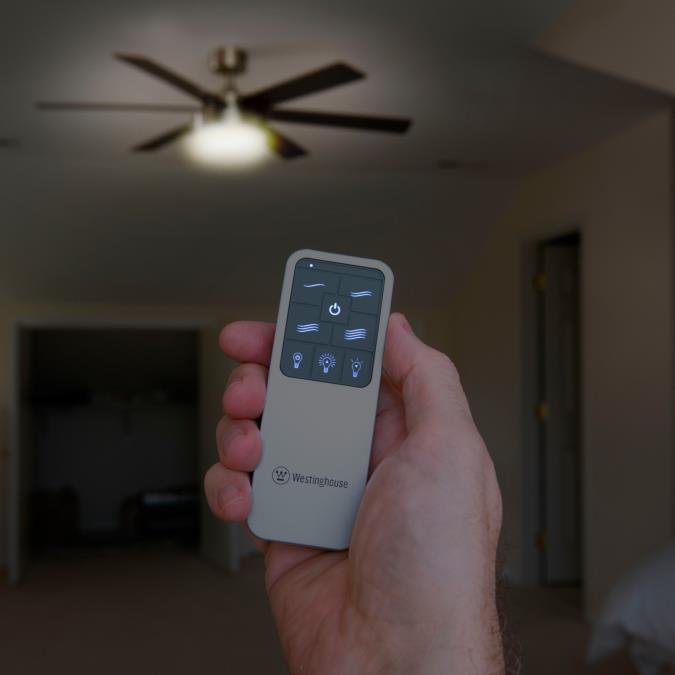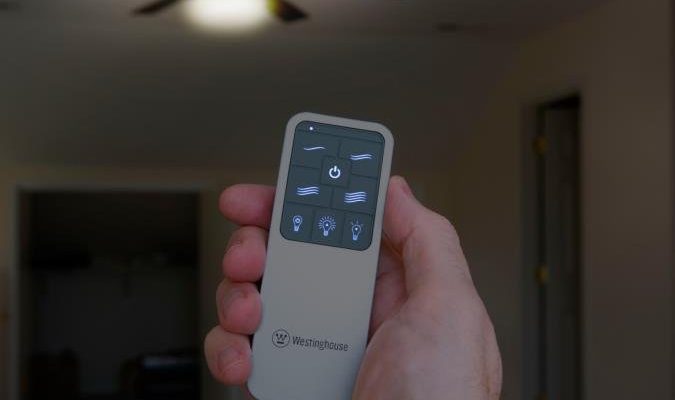
The idea makes perfect sense in an era when phones already control our lights, music, even our garage doors. Westinghouse is a well-known brand for ceiling fans, and their remotes are both convenient and—let’s be honest—easy to lose. So, the question pops up: Can your smartphone actually replace that Westinghouse ceiling fan remote? Or is it wishful thinking, like hoping your pet cat will fetch your mail?
Let’s break down what’s possible, what’s fantasy, and whether you can really skip the remote entirely in favor of your trusty phone.
How Westinghouse Ceiling Fan Remotes Actually Work
Understanding the basics here saves a lot of time and frustration. Westinghouse ceiling fan remotes aren’t just simple clickers—they’re part of a specific control system. These remotes usually use **RF (radio frequency)** signals to communicate with a receiver installed in your fan. Think of the receiver as a tiny “listener” inside the fan canopy, waiting for coded instructions like “turn on,” “change speed,” or “reverse direction.”
Unlike your TV remote, which usually uses infrared (line of sight), Westinghouse fan remotes can work anywhere in the room—even from behind a wall. This is great for convenience, but here’s the thing: your smartphone doesn’t natively speak RF. It’s like your phone speaks English and your fan remote speaks Morse code.
Some Westinghouse remotes also include DIP switches for pairing, syncing, or resetting. These tiny switches set a unique code for the remote and receiver so your signals don’t interfere with the neighbor’s fan. If you’re thinking about pairing a new remote or syncing after a battery change, that code matters a lot.
So, unless your phone can somehow mimic these RF signals, the direct swap isn’t as simple as downloading an app.
Smartphone Compatibility: What’s Possible and What’s Not
You might be wondering, “Can I just use a universal remote app or a smart home gadget?” Sadly, most smartphones can’t natively send out RF signals like a Westinghouse ceiling fan remote. That means, by default, your phone is out of the running for direct control.
However, there are workarounds—sort of like using a translator between two people who don’t speak the same language. Some universal smart home hubs, like Bond Bridge or certain smart IR/RF controllers, act as the middleman. You teach the hub the fan’s RF code, then control things from your phone through that hub’s app.
Here’s the catch: **not all Westinghouse fans play nice with every hub**. Compatibility depends on the model, the remote frequency, and the hub’s learning capabilities. You’ll often need to “teach” the hub your remote’s code, which can involve some trial-and-error. And if your remote is broken or lost, this gets trickier since you need that original signal to start.
So, technically, it’s possible—but not plug-and-play. You can’t just download a Westinghouse fan remote app and expect it to magically work. You’ll need some extra hardware and patience.
What You Need to Control a Westinghouse Fan with Your Smartphone
Let me explain how this works step-by-step if you’re determined to swap your remote for your smartphone.
- Compatible smart hub: Devices like the Bond Bridge, BroadLink RM Pro, or similar RF smart hubs can learn the codes from your original remote and relay them to your fan. Make sure the hub supports the frequency your fan uses (commonly 433MHz or 315MHz for RF remotes).
- Original working remote: Teaching the smart hub your fan’s code typically requires a functioning remote. No remote? You may be stuck unless you can find the exact code online—which is rare for branded remotes.
- Westinghouse fan receiver installed: The RF receiver in your ceiling fan has to be compatible with the hub, and not all receivers can “learn” new signals. Some are locked to the remote they shipped with, using a fixed, unique code (set by the DIP switches).
- Time for setup and troubleshooting: Don’t expect things to work on the first try. Pairing, syncing, and resetting codes can take a few attempts. Sometimes, you’ll need to reset the hub or fan receiver and repeat the process.
If all those pieces come together, you can link your phone to the hub’s app, then send commands to your fan. But again, this requires some technical effort—not just a quick app download.
Limitations and Issues With Smartphone Control
Here’s the thing: even with all the right gear, using your smartphone instead of a Westinghouse ceiling fan remote isn’t always perfect.
First, **reliability** can be a problem. RF signals might not always reach the fan from where your hub sits. Imagine you tuck your smart hub behind your TV—sometimes, it struggles to get the signal through walls or over longer distances. The original remote often works better across your whole room.
Second, **setup headaches**. If your Westinghouse fan uses a remote with unique DIP switch codes, the hub may not be able to clone or sync properly. Some Westinghouse receivers just won’t “hear” the command from the hub, no matter how many times you reset or pair.
Battery issues aren’t a problem for your phone, but the hub itself may need power—a dead hub means your smartphone is out of luck. Plus, if your home Wi-Fi flakes out (most smart hubs rely on it), you lose smartphone control until the network comes back.
And honestly? The cost and time investment can be greater than just buying a replacement Westinghouse remote. If you love tinkering, though, it can be fun to try.
Alternatives: Universal Remotes vs. Smart Hubs
Some folks ask if there’s a “universal remote” for ceiling fans. Well, yes and no.
– **Universal remotes** for ceiling fans exist, but they’re often designed for fans with standard receivers. Most need replacing the receiver in the fan canopy—a process that involves wiring and safety precautions. If you’re handy with tools, it’s possible. But it’s more work than just using your phone.
– **Smart RF/IR hubs** are the better fit for phone control if your fan’s receiver is compatible and you have the original remote. These hubs sit between your phone and the fan, translating app commands into radio signals.
Here’s a visual comparison:
| Option | Requires Wiring? | Smartphone Control? | Works with Original Receiver? |
|---|---|---|---|
| Universal Remote Kit | Yes | No (remote only) | No—replaces old receiver |
| Smart RF/IR Hub | No | Yes (via app) | Usually, if compatible |
| Original Westinghouse Remote | No | No | Yes |
Sometimes the simplest answer is getting an official replacement remote and calling it a day. But if you want everything on your phone, smart hubs are worth a try—just expect some trial and error.
Pairing and Syncing: What to Do if Your Remote is Missing
If you’ve already lost your Westinghouse ceiling fan remote, things get tricky. Most smart hubs need a working original remote to “learn” the codes. You might find threads online with code lists for certain remotes, but Westinghouse codes aren’t always publicly documented.
If you do get a new remote, here’s how typical pairing works:
- Set the DIP switches on the new remote to match the receiver in your fan. These tiny switches are usually inside the battery compartment.
- Reset the receiver if needed (unplug the fan briefly or flip the breaker).
- Test for sync by pressing “power” or a speed button. If the fan turns on, you’re paired and ready.
If you want to code your smart hub, you’d point the original remote at the hub to teach each command. No remote = no code = no smartphone control. That’s the plain truth—unless you replace the receiver with a smart model that’s fully designed for app control.
When a Replacement Remote Makes More Sense
Honestly, sometimes it’s just easier to find an original or compatible replacement Westinghouse ceiling fan remote. Swapping battery, resetting, or syncing a new remote is usually far less hassle than configuring a smart hub. Replacement remotes are designed to match your model’s code and frequency, guaranteeing out-of-the-box compatibility.
If you use the fan daily and want reliability, a physical remote is still king. There’s zero lag, no app updates, and no lost Wi-Fi signal to worry about. You’ll save yourself a weekend of troubleshooting and possibly some gray hairs.
That said, tech lovers and smart home fans might enjoy the satisfaction of controlling everything from their phone. Just know what you’re getting into before you start ordering hubs and inventing new workflow charts for your living room.
Summing Up: Should You Use Your Smartphone Instead of a Westinghouse Ceiling Fan Remote?
Here’s the bottom line: controlling a Westinghouse ceiling fan with your smartphone isn’t impossible, but it isn’t as simple as downloading an app. Most Westinghouse fan remotes use RF signals that your phone can’t natively send out. Smart hubs can fill the gap, but only if you have the right gear and a bit of patience for setup, pairing, and troubleshooting.
If you’ve still got your original remote, a smart RF hub could let your phone take over—just check compatibility first. If your remote is gone, though, you’ll likely need a replacement remote or even a new receiver before tapping into smartphone control.
In the end, while it’s fun to dream about ditching all remotes in favor of one sleek phone app, for most Westinghouse ceiling fans, the good old-fashioned remote is still your most reliable bet. If you’re tech-curious, experimenting with a smart hub can be rewarding—and if you ever succeed, you’ll probably be the hero of your next family get-together (as everyone marvels at your phone-powered fan). But don’t toss that remote just yet—it might still have a few tricks left in it.
